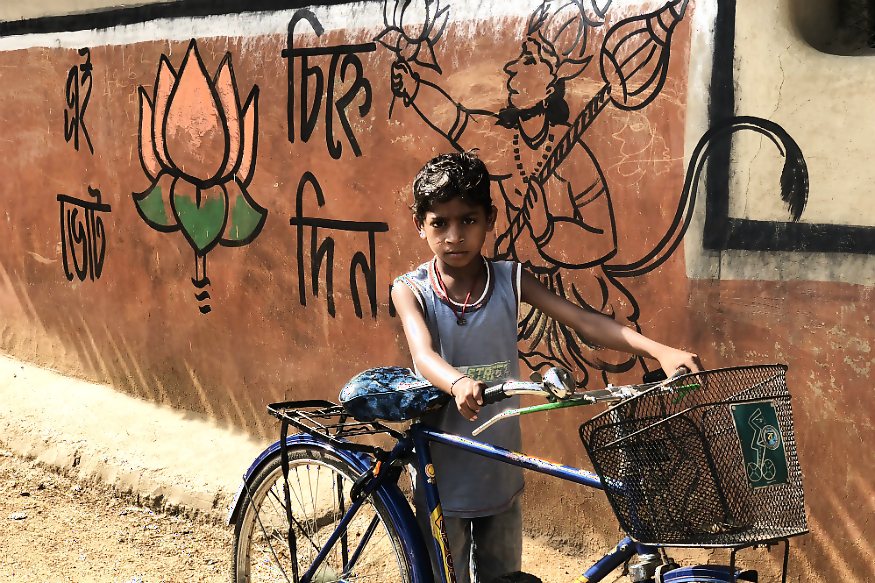
views
Kolkata: Dinobondhu Mahato (62) of Purulia’s Balarampur block identifies himself as a baampanthi (Leftist), but he will vote for the BJP in the Lok Sabha elections. This, he argues, doesn’t have to do with ideology but necessity. “We voted out the Left and if need be, we will vote out the BJP too,” he said.
The necessity, he explained, “The Trinamool Congress (TMC) has become exactly what it promised to get rid of. It is Baamer shesh din (last days of the Left) all over again.”
From Cooch Behar in Bengal’s extreme north-east to Purulia at its south-western border, there are few things that people agree on. But the phrase Baamer shesh din evokes near identical responses in almost all conversations.
In his 2011 essay, Pranab Bardhan, an economist, argued that in the name of Marxism, the party had become 'an all-powerful local mafia that would aid in true Godfather style during emergencies, but also fleece and intimidate the common populace.'

A child wheels out a cycle received by his sister as a government scheme in a village that switched to BJP during Panchayat polls in Purulia
This, Mahato and many others like him, argued had become a central tenet of the Trinamool Congress. “This isn’t to say that Mamata Banerjee isn’t trying or that her government isn’t sending money for development to the villages. It is just that only a few people seem to benefit and the common thing that they all have is that they are all TMC party workers.”
As a BJP state committee leader put it, “If it was just religious polarisation, we wouldn’t stand a chance. Keep in mind that in 2014, the total votes polled for the TMC were equal parts of Hindu voters and equal parts Muslim voters.”
‘Mamata Has Lost Control Over Cadre’
Mamata Banerjee’s victory in 2011, dethroning the Left Front that had ruled for 34 years, saw her immediately begin a process of consolidation. She started strengthening her party in pockets that had traditionally voted for either the Left or the Congress as she systematically began increasing the TMC’s political imprint.
By 2016, the TMC had won 213 of the 295 seats (72 percent). The feat was astounding. Even at the height of their powers in 1987, when the Left Front received 53 percent of total votes polled in the state, the CPI(M) won only 187 seats. Together with its allies, it won 250 seats in the 294-seat Assembly.
From Cooch Behar to Jhargram, voters said this dominance had its consequences. Before coming to power, the TMC had consistently criticised the Left for turning the party into an all-seeing, all-controlling machine that was more interested in winning elections. This, Abhijeet Mazumdar, son of Charu Mazumdar and the Darjeeling district secretary of the CPI-ML (Liberation), described as a “Sarkari Left” characterised by “social control and surveillance.”
Shamik Sen, a resident of Alipurduar, had fallen in love with a girl from his city while working in Kolkata and wanted to marry her. “But it didn’t happen. In my neighborhood, the TMC dominates. They made it very clear that the girl, and her family are BJP supporters and they wouldn’t stand for it,” he claimed.
The TMC denies the charge, but Sen said he won’t vote for the TMC. At Jhargram, a seat dominated by tribal community and earlier impacted by Left-wing extremism, Somla Hembram, a school teacher at Keshiyari said, “There were jobs that were going to be advertised at the schools here. But the party gave it to those who sympathised with them.”
In particular, there is anger over the recently concluded Panchayat polls in the state, which the BJP alleges saw over a 100 murders and PM Narendra Modi recently described as being more violent than in Kashmir. At Basirhat, a seat that has steadfastly voted for the TMC, Anarul Biswas said, “I told the TMC cadre that I am a supporter, a Didi fan. I even tried to show them that I like her on Facebook, but they still beat me up. What was the point?”
How Long Does the Gratitude Last?
Ahead of the 2016 Assembly elections, there was a sense of gratitude for Banerjee across major parts of the state, something her party was aware of and relied heavily on. For instance, at a rally in March 2016, she was introduced as Mukti Data (saviour) and Jungle Mahaler Kranti Data (giver of revolution to Jungle Mahal). At her last rally of the campaign in Cooch Behar, she was again introduced as Agni Kanya (daughter of fire).
While the epithets remain, the question of how long such gratitude lasts remains. The popularity of the many schemes that Banerjee introduced in her first term, from cycle for girls in schools to rice at Rs 2 per kilogram, has waned in many areas. Even the Left, with its land distribution or tenurial security rights, found out to their bitter experience that gratitude for received rights doesn’t necessarily mean an obligation for votes. As Abishek Dasgupta (24), a resident of Howrah said, “Before Banerjee, the roads weren’t clean and elsewhere, there were no roads. She has done a lot. But at the end of the day, I don’t have a job. Something needs to change.”
That isn’t to say that Banerjee’s popularity has diminished. Dasgupta, for instance, said that he was a “die-hard Didi fan” but blamed the party cadre on the ground. “They control the disbursal of these welfare schemes. There is widespread corruption.”
BJP as Bengal’s ‘Third Front’
In the Left versus TMC narrative of Bengal’s politics that has dominated the state since the formation of the latter in 1998, BJP leaders said their political strategy has revolved around projecting themselves as a viable ‘third front’. Their campaign, summarised by its slogan, ‘Ei Trinamool aar na’ (This Trinamool no more), reiterates this. Meanwhile, the BJP added that the oft-quoted TMC slogan, ‘Ei BJP aar na’ (This BJP no more) only emphasises the saffron party’s importance, said leaders.
“Even before the 2016 campaigns, we were seen as a third-party, especially with the Left and the Congress getting together. This was a blessing in disguise for us. Banerjee had focused her efforts on the two and the TMC sought to decimate them. There was a vacuum left behind and we have taken up the space,” said a BJP state and election committee member.
However, the TMC leaders claimed that the absence of a Left-Congress alliance had the potential to benefit the TMC. A source close to Banerjee told News18, “She is confident that in absence of an alliance, the Muslim voters of Bengal aren’t willing to waste their vote on either party. They know that in order to stop the BJP, they have to vote for Didi.”
But will it be enough? The confidence in some sections of the BJP’s state unit has started dipping, a BJP source admitted. The source pointed out that the BJP leader Kailash Vijaywargi’s insistence that the Election Commission (EC) increase the deployment of central paramilitary forces and install CCTV cameras for the remaining six phases of polls in Bengal isn’t without reason. “The first phase was a test. We were leading in Cooch Behar, but our information is telling us that the TMC gained last minute in nearly 7,000 booths. That is nearly 70,000 votes. That could be decisive,” said the source. A BJP state committee leader added, “We just don’t have the organisation on the ground that the TMC has. It proved critical in Cooch Behar and if the same pattern continues, it will not be a good thing for us.”



















Comments
0 comment